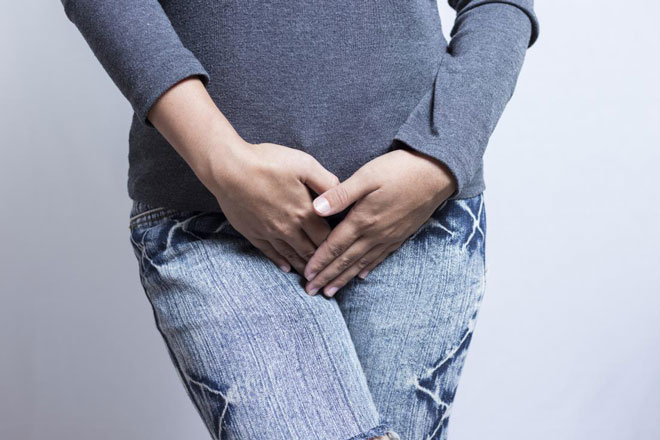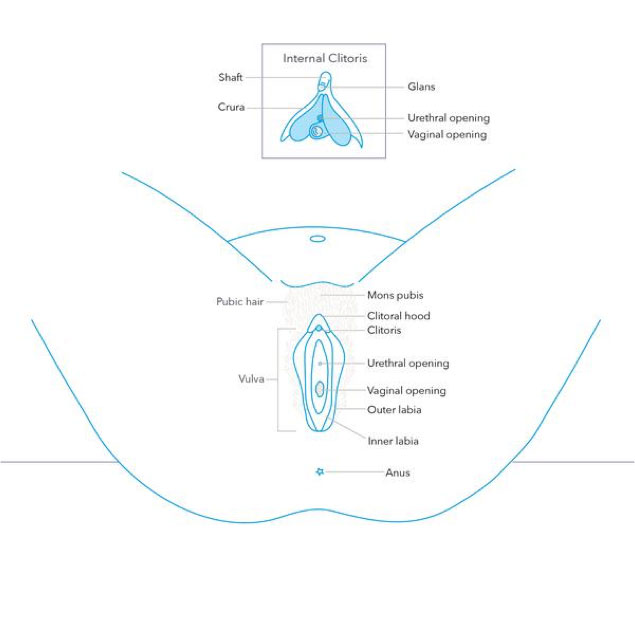Vulvar Pain
09
July
2021

It is said that the female body is truly unique, and it is indeed true. The sexual anatomy of a female includes internal parts and external parts, and every organ in these parts has a specific function. The female reproductive system is in charge of producing female hormones, releasing eggs during ovulation, providing a safe place for a fertilized egg during pregnancy, and most importantly, conceiving and giving birth. Here are the different organs in both the internal part and the external part, shown in the picture below.

What is the vulva?
The external part of the female genitals is called “the vulva”, and in simple words, it can be defined as the group of organs which are outside of the body. It has many structures, and each of them has a specific function:
Mons pubis: This part is mainly formed of tissues located on the pubic bones, and it gets covered in pubic hair, when the girl hits puberty.
Clitoris: It is formed of tissue, which is extremely sensitive to arousal or stimulation, as it has a lot of nerve endings. It is located at the top of the vulva.
Urethral opening: It is located directly under the clitoris, and it is the small hole responsible for throwing urine out of the human body.
Vaginal opening: The vaginal opening is located below the urethral opening, and it is a muscular tube, extending all the way to the internal parts of the reproductive system. It is where intercourse happens, menstrual blood and hormonal discharge leave the body, and babies come out.
Labia: Also called “lips”, the labia are tissues of skin which surround the vaginal opening. The labia minora, also called inner labia, are the tissues located on the inside, and are connected to the vagina. The labia majora, also called outer labia, are the outside tissues, located under the mons pubis, and they are usually covered with pubic hair.
Function of the vulva:
Reproductive organs do not usually have important non-sexual functions. Therefore, the vulva is mainly responsible for protecting the inner parts of the female genitals, it also plays a key role during sexual intercourse and facilitates it.
Pain in the vulva?
While many women use their genitals to enjoy their sexual lives, others suffer from conditions which affect these organs, and affect their entire health. If a woman suffers from pain around the vulvar area, it is likely that she has a condition called “vulvodynia”. According to Healthline.com, almost sixteen per cent of American women have suffered from this condition throughout their lives: “Vulvodynia can occur at any age, but recent research has found that women between the ages of 20 and 40 years are most likely to experience it.” (2021).
How can a woman know that she has vulvodynia?
Mainly, when the woman feels pain in her vulva for longer than three months, it means that she definitely has vulvodynia. It should be noted that symptoms for this condition are not always persistent; they might come and go depending on the woman’s sexual activity, menstruation cycle, or the daily activities that she does. Also, when a woman has vulvodynia, the vulva will still look absolutely normal and healthy, in spite of the condition. The symptoms that can be felt are:
Pain when sitting down.
Burning or stinging sensation in the area.
A feeling of irritation and itching.
Aching sensation while having sex or inserting a tampon.
Pain from wearing tight pants or underwear.
A tightening of the muscles surrounding the vagina.
Pain spreading all through the entire reproductive system and the anus.
What are the different types of vulvodynia?
There are four main types of vulvodynia.
Generalized vulvodynia: Women suffering from this type of vulvar pain get spontaneously affected by it. It suddenly occurs and aggravates when applying pressure to the area (e.g., while sitting down for too long, when wearing tight pants). Pain can persist for months or even years if not treated.
Localized vulvodynia: As its name refers to it, localized vulvodynia is mainly a sensation pain in one specific part of the vulva. For example, some women experience pain on the right labia only, or on the clitoris. This condition can also last for several months if not treated.
Provoked vulvodynia: Also called “vulvar vestibulitis”, it is the type of pain which impacts the surrounding of the vaginal opening. It occurs when something enters the vagina, especially during intercourse or after it.
Cyclic vulvitis: This type of pain occurs at the beginning of the woman’s cycle, mainly when menstruation starts, and it isn’t persistent. It comes and goes throughout the entire cycle.
What are the different causes that could lead to vulvodynia?
The main cause of vulvar pain is not quite determined yet, and according to WebMD, “ […] there’s no proof that infections, such as sexually transmitted diseases (STDs), lead to vulvodynia.” (2021). Ongoing research is being done in order to identify some of its causes, and scientists came up with the following reasons:
Trauma or injury to the nerve that leads to the vulva.
Inflammation due to hereditary factors.
Muscle spasm and weakness.
Alteration in the hormones.
A hypersensitivity to yeast.
Inability to fight infections.
Allergies and sensitivity.
Sexual abuse.

How can vulvodynia be diagnosed?
As there isn’t a specific cause for this condition, healthcare professionals have been trying to find the right diagnosis for the pain. Mainly, the gynecologist starts with an elimination procedure; they rule out all the possible causes which do not apply in the situation. An accurate analysis of the patient’s medical history is done, and the healthcare professional asks all the right questions to get a general idea of the case and determine the location and intensity of the pain. Then, a thorough examination of the entire area is done, to find out if there is an infection. Also, the doctor might recommend a blood test, to check the level of estrogen, testosterone, and progesterone, as any deficit in these hormones might be a reason behind vulvar pain.
If all those diagnosis methods do not lead to the identification of the issue, then a biopsy of a small tissue taken from the vulva is recommended, in addition to a pelvic exam.
NOTE: According to the National Vulvodynia Association (2021), “some women with vulvodynia also suffer from other disorders, such as interstitial cystitis (painful bladder syndrome), irritable bowel syndrome, fibromyalgia, temporomandibular joint and muscle disorders, endometriosis and/or chronic fatigue syndrome”. It is important to note that some women experience vulvodynia because of the mentioned issues, which is why it is incredibly necessary to understand all the symptoms and the reasons behind them, before undergoing any test.
What are the treatments of vulvodynia?
Although vulvodynia isn’t a dangerous condition, and its effects aren’t life-threatening, however its symptoms can alter the woman’s daily life and can cause frustration: “A National Institute of Health study showed that most women with vulvodynia feel ''out of control,'' unable to have sex and unable to fully enjoy life.” (WebMD, 2021). So, how can this condition be treated? Mainly gynecologists will advise some pain management therapies to help with the sensation, however, not all methods work on every woman. This is why doctors try out many treatments in order to reach the right one. Here are some of the methods.
Pain relieving medications: Gynecologists might prescribe some of the known painkillers (the ones taken to reduce chronic pain) in order to relieve the ache. There are many types that could be given, depending on the situation of each woman.
Topical medications: These types of medications are not taken orally; they are used to treat the exact spot of the pain. They could be hormonal creams, which are applied to tighten the muscles of the vulva, or anesthetic creams, which are applied to relieve the pain, especially prior to intercourse.
Pelvic floor muscle therapy: For women with muscle spasm, this type of therapy is ideal to treat its exact cause. It is mainly aimed at massaging the muscles, mobilizing tissues, exercising, and more. Also, the insertion of the machine shown in the picture is effective in the rehabilitation of the muscles.
Neurostimulation: This method is used when all other treatments fail to solve the problem. A small pump is inserted into the vulvar area, sending low signals to the nerves, which act like substitutes for the sensation of pain.
Surgery: Surgery is recommended in advanced cases, when women suffer from dangerous problems in the vaginal area. In the most common surgeries, either a small tissue from the vulvar area is removed, or the vestibule is removed.
Usually, with vulvodynia, women don’t reach the phase of advanced medicine; some simple home remedies can be applied to alleviate the pain, and they are:
Decreasing the use of irritating and non-medical soap or bath wash.
Wearing 100% cotton underwear.
Using the right kind of pads and tampons during period.
Avoiding swimming in pools with a high chlorine level.
Following a diet in which you remove all acidic and sugary food.
Rinsing the vulva after urinating and having sex.
Opting for unscented products in the area.
Wiping from the front to the back after urinating.
Wearing loose pants and avoiding pantyhose.
Vulvar pain is a condition that is constantly being studied. Fortunately, all indications show that nothing dangerous arises from vulvodynia. However, it is always important to stay in the safe side and contact a medical professional, whenever the person feels an unusual sensation, or if the pain lasts for longer than normal.
If you or anyone you know is suffering from pain, call us today on (469) 562 4188 to book an appointment with our expert doctors.